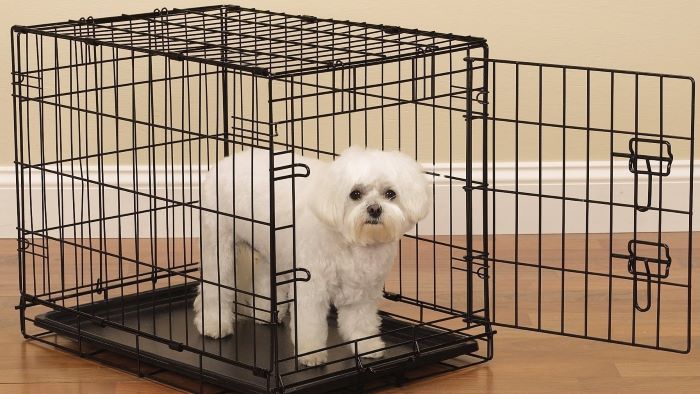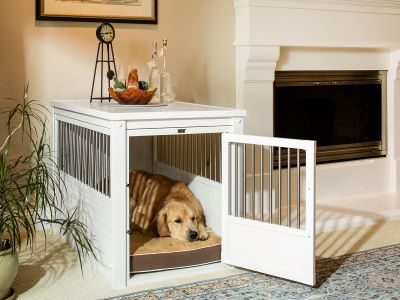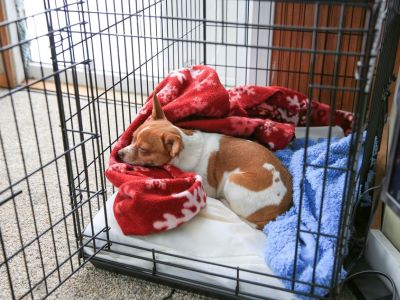Finding the perfect size crate for your furry companion is essential for their comfort and well-being. In this post, we’ll guide you through measuring your dog and customizing the crate based on their breed, growth potential, and mobility needs. Get ready to create a cozy haven where your four-legged friend can relax and thrive!

Contents
What Is Dog Crate?
A dog crate is a small enclosure, usually metal or plastic, that keeps dogs safe and cozy. It gives them a den-like space to relax, sleep, or hide. Crates help with house training, travel, and making a dog’s own spot in the home.
Types Of Dog Crate
- Wire Crates
- Plastic Crates
- Soft-sided Crates
- Wooden Crates
1. Wire Crates
Metal wire mesh is used to make widely used and adaptable wire crates. These give your dog exceptional views and ventilation so they can see their surroundings.
- Features: Metal bars or mesh are used to create the cage-like construction of wire crates. They typically feature one or two doors that have latches that can be locked.
- Pros: For dogs’ convenience, cleanliness, and adaptability, wire crates are ideal. They are suitable for a variety of needs and preferences, allow dogs to see and breathe freely, and are simple to clean and odor-free.
- Cons: Wire crates are uncomfortable, unsafe, and unattractive for dogs. They can cause cold and noise, be damaged or harmful due to canine behavior, and look unattractive and large in your home.
2. Plastic Crates
A sturdy, reusable container constructed of plastic is a plastic crate. It is portable, stackable, and chemical- and moisture-resistant. Plastic crates are a sustainable solution since they are lightweight, simple to maintain, and recyclable.
- Features: Plastic crates are made of hard plastic shells with wire doors. They usually have handles or holes for carrying. They also have vents or windows for air circulation.
- Pros: Plastic crates are durable, lightweight and easy to carry in nature they also give more privacy and coziness to dogs.
- Cons: Plastic crates may not provide proper ventilation or visibility for some dogs and also it is very hard to clean them.
3. Soft-sided Crates
Soft-sided Crates create comfort for your pet and it is suitable only for well-behaved pets.
- Features: Soft-sided crates are fabric and mesh crates with zippers or Velcro. They have pockets or pouches and can be folded flat.
- Pros: Soft-sided crates are good for small or snuggly dogs. They are easy to set up and fold. They are less noisy and cold than wire crates.
- Cons: Soft-sided crates are not sturdy or secure, and may be chewed or scratched by dogs. They are not good for potty training or air travel. They may be harder to clean and smellier than wire crates.
4. Wooden Crates
Wooden crates offer a natural and aesthetically pleasing option for dog containment. They are typically handcrafted from wood, providing a rustic and stylish look.

- Features: Usually, they have lockable doors or gates. Moreover, they have solid or slatted walls that offer warmth and privacy.
- Pros: Custom-made wooden boxes have the appearance of furniture. Usually, they have lockable doors or gates.
- Cons: Hardwood containers are pricy, hefty, and difficult to transport. If your dog chews or soils them, they could also be difficult to clean or smell-free. Some dogs might not get adequate ventilation or visibility from them.
5. Heavy-Duty Crates
These Demonstrates the crate’s superior strength and security. They can withstand challenging circumstances, hard handling, and big loads. Strong locking systems are in place to guard against strong and powerful dogs or those prone to escape attempts. The title highlights the advantages of sturdy boxes in terms of strength and security.
- Features: Heavy-duty crates offer security, strength, and durability. They have reinforced corners and edges and are constructed of sturdy materials. They resist impact and feature sophisticated locking mechanisms.
- Pros: It increases security, strength, and durability. They guard against strong dogs and for those dogs who are prone to escape attempts. They can be employed in a variety of settings and businesses.
- Cons: In comparison to standard crates, heavy-duty crates are larger, more expensive, and heavier. They could also be less open to customization or adaptation. Some people or situations could find these downsides difficult.
Measuring Your Dog
Considering your dog’s breed, size, and proportions, you can ensure a crate that offers optimal comfort and adequate space for your furry friend.
Breed
The sizes and body proportions of different dog breeds vary. In doing so, you may make sure that the crate has enough room for your dog to stand up, turn around, and lay down without feeling cramped.
Size
You have to measure your dog from the tip of the nose to the base of the tail. This will give you the height and length of the dog.
Proportion
We must take into account the proportion that certain dogs may have longer bodies or taller legs than the breed norm.
Ensuring Comfort and Mobility
By providing enough space, considering height and length, optimizing door placement, and adding comfortable bedding, you can ensure that your dog has the comfort and mobility they need within their crate and for that we have to consider following:

Adequate Space
The crate size matters for your dog’s comfort and behavior. It should fit your dog’s length and height plus 4 inches. A crate that is too small or too big can cause stress or accidents. You can use a dog crate size chart to find the best fit for your dog based on their measurements and breed.
Height and length Of The Dog
The size of the crate is appropriate for your dog’s height and length. The crate should not be touched or crowded by your dog while it is inside.
Your dog should be able to stand, sit, and lie down with ease. Breed, age, and health all affect your dog’s length and height. Some breeds require larger crates.
Your dog might expand or contract. For the comfort and wellbeing of your dog, select and modify the crate size.
Door Placement and Size
Size of the crate and door placement are important. You should carefully and securely open and close the door. Your dog ought should be able to enter and exit the container without difficulty or anxiety.
According to the crate’s type and shape, the door’s placement and size differ. Crates can come with one, two, or three doors. You must pick a door that works for your needs, preferences, and convenience.
Add Comfortable Bedding
What’s inside the crate’s bedding counts. In the crate, you want your dog to be able to rest and sleep soundly. Soft, warm, long-lasting, and simple to clean bedding should be included.
Towels, mats, pads, pillows, cushions, blankets, and old clothing are all acceptable materials. Your dog’s breed, age, health, and personality may all influence the bedding you choose.
Adjusting For Puppies
Anticipating growth, utilizing divider panels, and regularly reevaluating your puppy’s crate size, you can ensure they have a comfortable and appropriately sized space as they transition from puppyhood to adulthood.
Anticipating Growth
Choose a crate that will accommodate their anticipated adult size, taking into account the average growth rate for their breed.
Divider Panels
Many crates come with divider panels that can be adjusted to create a smaller space within the crate. This allows you to gradually expand the available space as your puppy grows.
Regular Reevaluation
Determine your puppy’s size frequently, and then adjust the crate. Pay attention to their crate comfort in terms of height, length, and overall condition.
Seeking Professional Advice
Seeking professional advice from veterinarians, dog trainers, and behaviorists, you can gain expert insights tailored to your dog’s unique requirements. Their expertise and experience will help you make informed decisions and select the most suitable crate size for your furry friend.

Veterinary Guidance
Consider consulting your veterinarian because they are skilled at determining your dog’s unique needs and can offer suggestions depending on breed, size, and health. Veterinarians can provide helpful advice and make sure that the crate size improves the welfare of your dog.
Dog Trainers and Behaviorists
Professional dog trainers and behaviorists can assess your dog’s behavior, activity level, and specific training needs to determine the ideal crate size that supports their training goals.
These experts can provide guidance on creating a positive association with the crate and using it effectively as a training tool.
Online Resources and Communities
There are various online resources, forums, and communities where experienced dog owners and experts share their insights on crate sizing. Engaging in discussions and seeking advice from these platforms can provide additional perspectives and guidance.
However, it’s important to ensure that the information obtained aligns with your dog’s individual needs and consult with professionals when in doubt.
FAQs
How Long Can I Leave My Dog In A Crate?
Adult dogs: 4-6 hours,
Puppies: 2-3 hours.
Ensure regular exercise, mental stimulation, and socialization outside of crate time.
How can I train my dog to remain in the crate?
Patience and consistency are key. Begin by closing the crate door for a few seconds and then reopening it. Reward your dog with treats and praise. Gradually increase the duration and distance of your absence. Provide your dog with a stuffed toy or chew to keep them occupied.
What are the advantages of crate training my dog?
Crate training offers several benefits such as aiding in house training, providing a safe and comfortable space for your dog, reducing separation anxiety and destructive behavior, and facilitating easier and safer travel.
How can I help my dog develop a positive association with the crate?
Create a positive and rewarding environment in the crate by adding toys, treats, and praise. Allow your dog to explore the crate and engage in playtime inside. Introduce a cue word like “crate” or “kennel” when they enter.
Conclusion
Your dog’s comfort and safety are balanced by the ideal crate size. They need to be able to stand, turn, and lie down at times, fit for their breed and demands. Your dog will be able to sleep, learn, and grow in the right crate. Provide a cozy environment for your dog within the crate to ensure a Happy pet.

Dania is a dog groomer living in California, who loves styling dogs. She often uses dog accessories to keep them distracted while grooming. She is also a dog parent to a Pomeranian, Duke. It’s because of him she is always on a lookout for the best dog foods, toys, other dog accessories, and ways to keep him equipped, healthy and happy.


